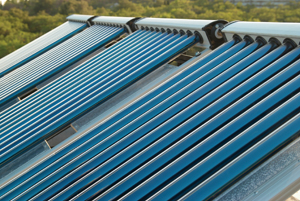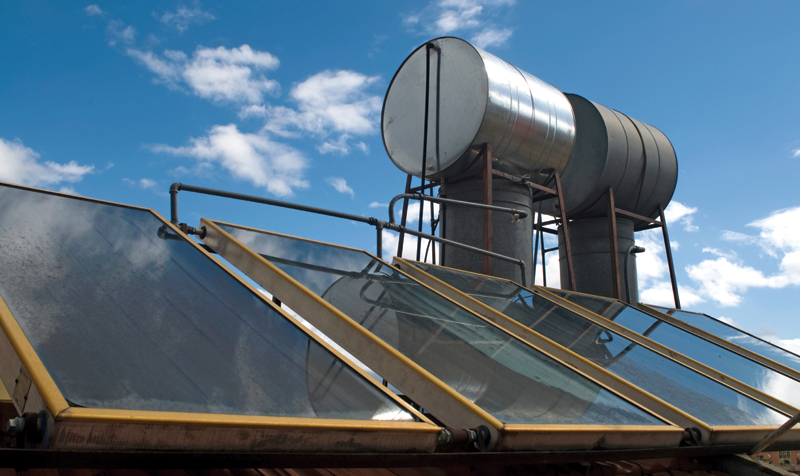Twenty to 40 percent of an average household heating bill is just for hot water. And that’s just for common household hot water usage, such as laundry, baths and showers, and dishwashing.
Most of us rely on a conventional storage water heater, whether it is powered by electricity or gas. It provides all the hot water we need, as long as its size is designed for the number of people in the household. It has a fairly long life, maybe 15-20 years, and when it goes we replace it with another standard water heater. But while you are out at work or on vacation, you are still paying to keep the water in the tank hot. There are a number of other, more efficient and cost-effective ways to heat your household water.
Solar Water Heaters
In the last issue, we discussed photovoltaic panels and their ability to harness the sun to create electricity to run your home. Solar water heaters can work with a PV system or alone to heat your household water. As with PV panels, the major criterion for using a solar hot water system is clear access to the sun from your roof or from an area close to your home. There is a system for every climate and all use free fuel—the sun!
There are several different types of solar water heaters with residential applications. It’s best to consult a professional to help you decide which is best for your home and family. Solar water heating systems are either active or passive. Active systems use pumps and controls (which require power) while passive systems don’t. A direct circulation system pumps household water through the collectors and into the home; it is better suited to warmer climates. Better for cold climates, an indirect circulation system moves a freeze-proof liquid such as antifreeze through the collectors and a heat exchanger and then into the home. There are four main types of residential solar water heaters:

Flat-plate collectors are ideal for colder climates, do a good job of collecting heat, and they are relatively attractive. They can be purchased as a kit, but unless you are a veteran DIYer, it’s better to have a professional carpenter and plumber install the system so that it meets local regulations. On the down side, the water temperature may not be a hot as you would like, and the system requires a pump and control systems that add to the cost.
Integral collector-storage (ICS) systems: Cold water passes through a solar collector consisting of one or more black tanks or tubes placed in an insulated, glazed box. Once the water is heated by the sun, it travels to a conventional back-up water heater. This system is a reliable source of hot water that is best suited to warmer climates where the outdoor pipes won’t freeze.
Evacuated-tube solar collectors: Each unit of the collector consists of two transparent glass tubes, one inside the other, separated by a vacuum. A copper pipe filled with a refrigerant runs inside the dual glass tubes and is attached to a black absorber plate. When heated by the sun, the refrigerant becomes a hot gas that moves to the top of the tube. The heat is transferred through a heat-conducting manifold into a solar storage tank.
Evacuated-tube solar collectors have a good performance track record and they are relatively attractive. They are more efficient than flat-plate collectors and ICS systems, but are also more expensive. They are ideal for cooler, less sunny climates.
Thermosyphon vacuum system: This system is a more sophisticated version of the evacuated tube system. An array of glass vacuum tubes are linked by valves to a large storage tank. The sun heats the water in the tubes and causes it to rise into the storage tank. This is a passive solar water heating system, so there are no pumps or exchangers that require power. It uses plain water, no chemicals. It’s very efficient, works on all roof types and at all angles, and it still works on a cloudy day. A medium-sized system will provide enough hot water for showers and kitchen use. The down side to this system is that the storage tank must be above the collector tubes and it may be too heavy or bulky for some roofs; and it may not comply with local regulations. It’s important to consult with a structural engineer before considering this type of system.
To purchase the right system for your climate and hot water needs, consult with a solar hot water heating contractor. The contractor will ensure that the system is installed according to local building code regulations and that it is safe and efficient to operate. After the system is installed, follow the manufacturer’s instructions or enlist the help of a contractor, especially for an active system, which has electrical components.
The federal government allows a 30 percent residential tax credit for a solar hot water system; this does not include hot water for swimming pools or hot tubs. Also look into tax incentives offered by your state.
Tankless (on Demand) Water Heaters
Cold water runs directly into the tankless water heater where a gas or electric heating element heats the water. There is no storage tank with this system; in fact, it’s so compact that it can hang on a wall or be installed in a closet. An electric system provides between two and five gallons per minute, which may not be enough for a family of four or more people, when one wants to do laundry and another wants to take a shower. The solution is to install more than one unit; a second one could be designated to handle laundry and/or dishwashing needs.

Rinnai tankless water heater
A gas tankless water heater has a slightly higher flow rate per minute, but some energy may be lost to operating the pilot light. Check with the manufacturer to see if the pilot light can be turned off, or shop for a model that has an intermittent ignition device (IID) instead of a pilot light. The IID works like a spark ignition on a stove or oven.
If your household uses 40 gallons of hot water or less, a tankless hot water heater will on average be 24 to 34 percent more efficient than a standard water heater. If your family consumes up to 86 gallons of hot water per day, the efficiency drops to 8 to 14 percent over a standard water heater. Efficiency jumps to 27 to 50 percent when additional units are installed in the home.
Tankless water heaters are more expensive than traditional water heaters, but they use less energy and so are less expensive to operate. They last as long as 20 years, have longer warranties, and their parts can be easily replaced. The system must be installed by a licensed heating and plumbing contractor, who will guarantee that all permits have been obtained and codes met. Although a tankless water heater can replace your existing water heating system, the ideal time to consider one is when you’re planning to build a new home. If you are installing a solar hot water system, consider using a tankless water heater as a back-up.
Heat Pump Water Heaters
Many of us have heat pumps that are used to heat and cool our homes, but a heat pump can also be used to heat water. They can be single systems designed just to heat water or they can be combined with other water and space heating/cooling systems. A stand-alone system can be purchased with a built-in water storage tank and back-up resistance heating elements.
A stand-alone air-source heat pump water heater does not generate heat directly; instead it draws heat from the air around it and transfers it to a tank where it heats the water. The system must be installed in an area that remains be-tween 40 and 90 degrees year round and it requires 1,000 cubic feet of space around it. The unit will release cool air into the space or can be vented outdoors. The ideal location is in a furnace room, which tends to be the warmest space in a home. They are not suitable for very cold climates.
Because it uses the home environment as the source of warm air, a heat pump hot water system can be two to three times more energy efficient than a conventional electric or gas water heater. The initial cost for the system is higher, but it is less expensive to operate. It should be installed and maintained by a qualified heating and plumbing contractor.
This is just a starting point for alternative ways to generate hot water for your home. A lot of information is available on the Web and from the manufacturers of the various systems. And new technology becomes available every year. If you are interested in installing any of these systems in your new log home, make sure you consult a professional and discuss your ideas with your log home producer.

